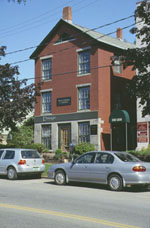

 196 Battery-The
Musicant Building
196 Battery-The
Musicant Building
by Doug Porter
In the first quarter of the nineteenth century this portion of Battery Street was a bustling center of commerce. The only building surviving from before 1830 is the Musicant Building at 196 Battery. This three-and-one-half story gable-fronted structure, neo-classical in style, features a front façade of tooled limestone on the first story and limestone window lintels in the brick stories above the first floor. During a 1976 renovation, a brick marked "1827" was found in the front façade.1 This was the same year the north half of the Stone Store was constructed across the street. The Musicant Building may have been built in conjunction with the store, out of the same limestone. The building seems to have been originally fitted with a block pulley in the rear gable, suggesting a commercial use, possibly as warehouse space for Follet's operation.2 There are other interesting buildings along Battery Street in the block between Maple and King Streets including the Merchant's Bank building, a Greek Revival-style structure featuring Doric pilasters and door and window lintels of stone. This building was constructed in 1849, and was home to Timothy Follett's Merchant Bank until 1857, at which time Battery Street went into economic decline.
Return to Burlington Waterfront
1 Register nomination, Battery-King Street Historic District, Burlington, Vermont-National Register of Historic Places.
2 There was a lot of activity along Battery Street in 1827. At the north end of the street, construction was begun on the glassworks. Some of the buildings were designed by John Johnson, who was the general contractor on Timothy Follett's Stone Store project that same year. Johnson's designs for the glassworks buildings survive and bear a remarkable resemblance to the Musicant Building, possibly constructed by Johnson.
Introduction | 1830 Young map | 1830-1988 overlay maps | Street index | Surviving 1830 buildings | UVM Historic Preservation Program